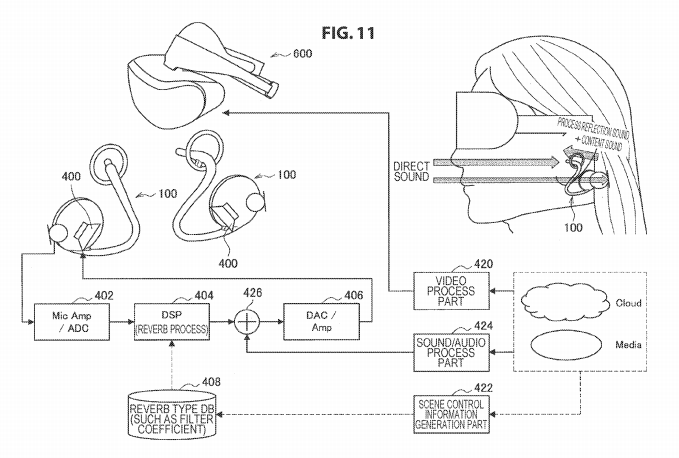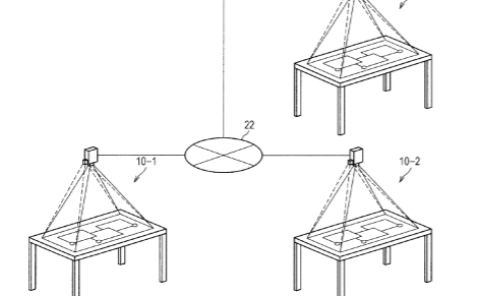Sony Patent | Sound Output Device, Sound Output Method, Program, and Sound System
Patent: Sound Output Device, Sound Output Method, Program, and Sound System
Publication Number: 20190019495
Publication Date: 2019-01-17
Applicants: Sony

Abstract
To allow a listener to hear sound acquired in real time to which desired reverberation is added. [Solution] According to the present disclosure, a sound output device includes: a sound acquisition part configured to acquire a sound signal generated from an ambient sound; a reverb process part configured to perform a reverb process on the sound signal; and a sound output part configured to output a sound generated from the sound signal subjected to the reverb process, to a vicinity of an ear of a listener. This configuration allows a listener to hear sound acquired in real time to which desired reverberation is added.
Background
Conventionally, for example, as described in Patent Literature 1 listed below, a technology of reproducing reverberation of an impulse response by measuring the impulse response in a predetermined environment and convolving an input signal into the obtained impulse response is known.
Summary
Technical Problem
However, according to the technology described in Patent Literature 1, the impulse response that is acquired in advance through the measurement is convolved into a digital audio signal to which a user wants to add a reverberant sound. Therefore, the technology described in Patent Literature 1 does not assume addition of a spatial simulation transfer function process (for example, reverberation or reverb) such as simulation of a predetermined space with respect to sounds acquired in real time.
In view of such circumstances, it is desirable for a listener to hear sounds acquired in real time to which a desired spatial simulation transfer function (reverberation) is added. Note that, hereinafter, the spatial simulation transfer function is referred to as a “reverb process” to simplify the explanation. Note that, hereinafter, the spatial simulation transfer function is referred to as a “reverb process” to simplify the explanation. Note that, not only in the case where there are excessive reverberation components, but also in the case where there are a few reverberation components such as a small space simulation, the a transfer function is referred to as a “reverb process” to simulate a space as long as it is based on a transfer function between two points in the space.
Solution to Problem
According to the present disclosure, there is provided a sound output device including: a sound acquisition part configured to acquire a sound signal generated from an ambient sound; a reverb process part configured to perform a reverb process on the sound signal; and a sound output part configured to output a sound generated from the sound signal subjected to the reverb process, to a vicinity of an ear of a listener.
In addition, according to the present disclosure, there is provided a sound output method including: acquiring a sound signal generated from an ambient sound; performing a reverb process on the sound signal; and outputting a sound generated from the sound signal subjected to the reverb process, to a vicinity of an ear of a listener.
In addition, according to the present disclosure, there is provided a program causing a computer to function as: a means for acquiring a sound signal generated from an ambient sound; a means for performing a reverb process on the sound signal; and a means for outputting a sound generated from the sound signal subjected to the reverb process, to a vicinity of an ear of a listener.
In addition, according to the present disclosure, there is provided a sound system including: a first sound output device including a sound acquisition part configured to acquire sound environment information that indicates an ambient sound environment, a sound environment information acquisition part configured to acquire, from a second sound output device, sound environment information that indicates a sound environment around the second sound output device that is a communication partner, a reverb process part configured to perform a reverb process on a sound signal acquired by the sound acquisition part, in accordance with the sound environment information, and a sound output part configured to output a sound generated from the sound signal subjected to the reverb process, to an ear of a listener; and the second sound output device including a sound acquisition part configured to acquire sound environment information that indicates an ambient sound environment, a sound environment information acquisition part configured to acquire sound environment information that indicates a sound environment around the first sound output device that is a communication partner, a reverb process part configured to perform a reverb process on a sound signal acquired by the sound acquisition part, in accordance with the sound environment information, and a sound output part configured to output a sound generated from the sound signal subjected to the reverb process, to an ear of a listener.
Advantageous Effects of Invention
As described above, according to the present disclosure, it is possible for a listener to hear sound acquired in real time to which desired reverberation is added. Note that the effects described above are not necessarily limitative. With or in the place of the above effects, there may be achieved any one of the effects described in this specification or other effects that may be grasped from this specification.


